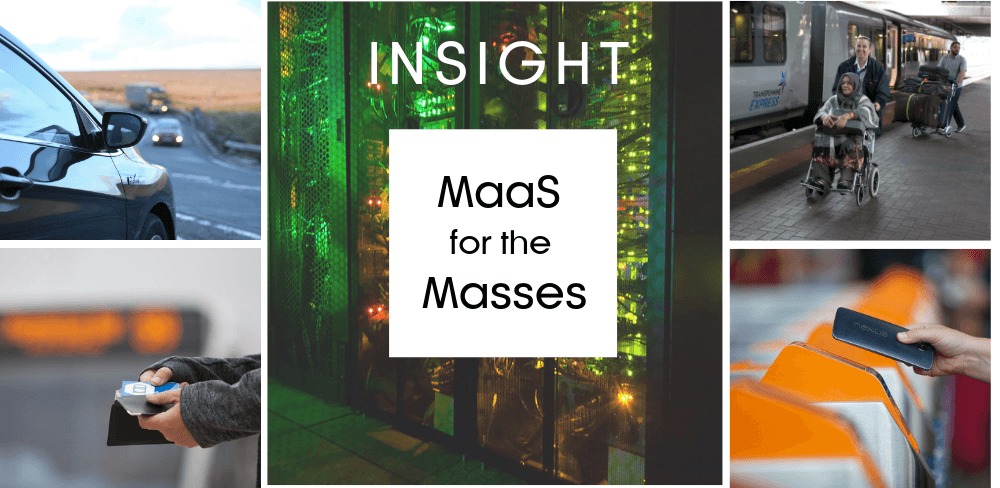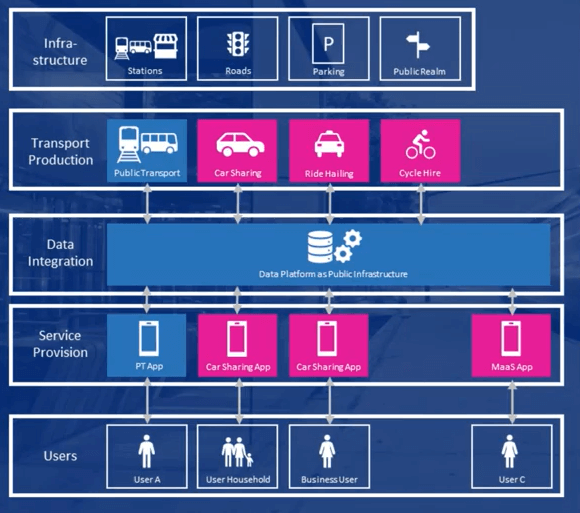Richard Bradley, Head of Data, Modelling & Appraisal, considers whether our development of data and smart ticketing could naturally progress to support Mobility-as-a-Service for the North.
At Transport for the North (TfN) we love to be open and collaborate. Our Integrated and Smart Ticketing (IST) team recently met our Transport Analysis, Modelling and Economics (TAME) team to share recent experiences and explore ways we might together exploit the great progress both teams are making.
IST officers explained how they are connecting service providers into a single, user centric system that joins up bus and rail with price capped journeys across the North. They explained how improving the customer’s experience through more seamless end-to-end journeys presents a unique opportunity to drive benefits throughout the North. And how the system will be used to coordinate customer information and broker the customer’s relationship with multiple service providers.
We discussed the three phases of the IST programme that include:
We also discussed how as Phase 3 develops we want to work with operators to identify and investigate potential datasets that, protected under licence, could be safely made available internally at TfN and externally if that can help improve the overall customer proposition.
The TAME team are always on the look-out for data to help understand the customer experience. This helps them build models that replicate as much of today’s customer experience as possible and then use these models to help understand the choices people might make in the future.
Introducing the TAME data analysts, modellers and economists to IST’s data opportunities had the desired effect. TAME officers discussed how the potential data could be used to more accurately represent the customer’s experience. They explained how this could help measure and model more components of the customers end-to-end journey, with IST data adding new payment and station components.
TAME deliberated how they could make more robust business cases and the great potential to move from business case planning activities, to monitoring, to operational support with the ever increasing ‘velocity’ of data.
TAME officers considered how this could be captured in further development iterations of the Analytical Framework. The Analytical Framework is TfN’s digital framework aimed at One North to deliver consistent and robust evidence for data, modelling and investment decisions.
The greater detail potentially available in the future could help capture more customer personas that could further improve how representative models are. This should help improve the confidence of customers and operators in the data and help support fairer investment decisions. And by also breaking down the components of the customer’s journey we have a better chance of modelling the impact of the multitude of future mobility options.
We considered how merging current modelling tools with data harvested from mobile devices and potential IST data could help break-down the annual average commonly used for building investment cases and thereby help move our digital world even closer to reality. And, considering the potential low latency of much of this data, how the Analytical Framework’s Data Fusion Engine could potentially feed data into rapid and believable next hour predictions.
So, what might be the next big phase for TAME and IST? How might TfN be involved in the next step-change for mobility in the North?
Rail is important to us because it’s the most sustainable inter-city, pan-northern mode. As such to help answer such massive questions I considered Northern Powerhouse Rail (NPR) as a case study, for which complimentary station access measures should help maximise NPR’s impact. And I considered the plethora of future mobility options that people and businesses might share across such a wide and varied geography.
I asked myself how might the North best exploit what we, at TfN, are creating?
By asking these types of questions I started to think that better connecting people to places with NPR and exploiting the potential of our creations started to sound like Mobility-as-a-Service (MaaS) for the North.
I tested this proposition with some of my TAME and IST colleagues. There was a general feeling that MaaS might be the next step-change for mobility in the North. And that there might be a future role for TfN to help support and coordinate MaaS for the North to provide a more holistic, data driven, customer centric, end-to-end customer experience.
In this context, MaaS for the North could present seamless customer options, automated based on customer preferences, to improve getting customers to their boarding station and from their alighting station. This could be a solution where the smart ticket customer can do much more than book their seat on NPR but also choose between booking a high-occupancy parking space at one station or a ride-share to another station. As well as book a cycle hire or taxi at their destination station.
This could be achieved by further evolving TfN’s service provider relationships to support the most ethical providers passionate about sharing. It could include expanding the account-based ticketing system to cover every component of the customer’s journey.
The increase in the velocity of data could be used to speed-up predictions to share next hour data with customers and service providers, with Met Office style coverage.
And recycling all this information back into the Analytical Framework could further improve the accuracy of measuring the customer experience in the North’s truly digital twin, providing feedback and insight to continuously improve decision making.
Fitting this digital approach with other ground-breaking initiatives, like the Bus Services Act 2017, could help us transform all aspects of the transport system and yield more robust, accurate and timely data ecosystems.
TfN governance might be the ideal vehicle to help support and coordinate the regulation of public infrastructure investment to support MaaS service providers, helping promote consistent station access options across the North. Such a governance role could help coordinate the associated data platform as public data infrastructure and help coordinate the digital interfaces to connect customers to MaaS service providers.
With public and private providers working together we could provide tailored customer information to achieve truly seamless journeys and also provide operators with trusted, safe and open estimates of customer demand.
And maybe the Data Integration layer in the graphic below from the European Metropolitan Transport Authorities summarises a key future role for TfN, exploiting the great potential that both IST and TAME teams are enabling.
I’d appreciate your thoughts on how TfN might support MaaS for the North by considering the same questions I asked myself.
Let me know your thoughts – [email protected]

Source: IMPACT>MOBILITY 2019 presentation by Thomas Geier of European Metropolitan Transport Authorities Mobility Redefined: Blurred Lines in Public/Private Transportation